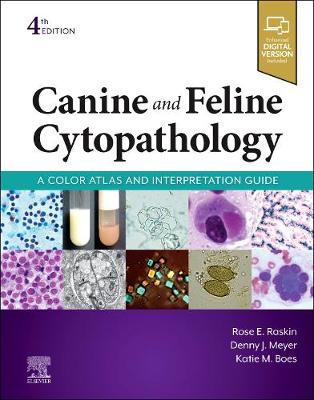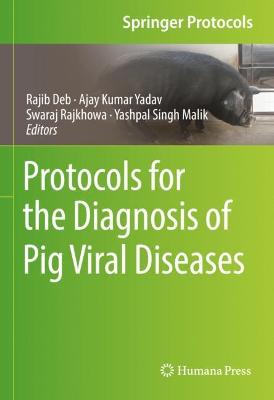Canine and Feline Cytopathology
 -10%
portes grátis
-10%
portes grátis
Canine and Feline Cytopathology
A Color Atlas and Interpretation Guide
Raskin, Rose E.; Boes, Katie. M; Meyer, Denny
Elsevier - Health Sciences Division
03/2022
744
Dura
Inglês
9780323683685
15 a 20 dias
2240
Descrição não disponível.
Chapter I. Simple Acquistion and Management of Cytology Specimens
A. General Sampling Guideline
B. Diagnostic Imaging-Guided Sample Collection
C. Managing the Cytologic Specimen
D. Staining the Specimen
E. Site-Specific Considerations
F. Submitting Cytology Specimens to a Reference Laboratory
G. References
Chapter 2. General Categories of Cytologic Interpretation
A. Normal Tissue
B. Hyperplastic Tissue
C. Cystic Mass
D. Inflammation or Cellular Infiltrate
E. Response to Tissue Injury
F. Neoplasia
G. Artefacts and Other Questionable Findings
H. References
Chapter 3. Skin and Subcutaneous Tissues
A. Normal Histology and Cytology
B. Normal-Appearing Epithelium
C. Noninfectious Inflammation
D. Infectious Inflammation
E. Parasitic Infestation
F. Epithelial Morphology Neoplasia
G. Mesenchymal Morphology Neoplasia
H. Round or Discrete Cell Morphology Neoplasia
I. Naked Nuclei Morphology Neoplasia
J. Response to Tissue Injury
K. References
Chapter 4. Hemolymphatic System
A. General Cytodiagnostic Groups for Lymphoid Organ Cytology
B. Lymph Nodes
C. Spleen
D. Thymus
E. Extramedullary Hematopoiesis
F. References
Chapter 5. Respiratory Tract
A. The Nasal Cavity
B. Larynx
C. Trachea, Bronchi, and Lungs
D. References
Chapter 6. Body Cavity Effusions
A. Collection Techniques
B. Sample Handling
C. Laboratory Evaluation
D. Normal Cytology and Hyperplasia
E. General Classification of Effusions
F. Specific Inflammatory Types of Effusions
G. Bilious Effusion
H. Chylous Effusion
I. Neoplastic Effusion
J. Hemorrhagic Effusion
K. Parasitic Effusion
L. Pericardial Effusions
M. Miscellaneous Effusion Findings
N. Ancillary Tests
O. References
Chapter 7. Oral Cavity, Gastrointestinal Tract, and Associated Structures
A. Oral Cavity
B. Salivary Gland
C. Esophagus
D. Criteria for Gastrointestinal Cytology
E. Stomach
F. Intestine
G. Colon/Rectum
H. References
Chapter 8. Fecal Cytology
A. Sample Collection and Processing
B. Normal or Incidental Microscopic Findings
C. Abnormal Microscopic Findings
D. References
Chapter 9. Pancreas (Exocrine/Endocrine)
A. Normal Cytology
B. Hyperplasia
C. Inflammation
D. Neoplasia
E. Ancillary Tests
F. References
Chapter 10. Liver and Gall Bladder
A. Sampling the Liver
B. Normal Liver Cytology
C. Normal Gallbladder Cytology
D. Non-Neoplastic Diseases and Disorders
E. Neoplasia
F. References
Chapter 11. Urinary Tract
A. Normal Anatomy and Histology
B. Specialized Collection Techniques
C. Normal Renal Cytology
D. Non-Neoplastic and Benign Lesions of the Urinary Tract
E. Neoplasia
F. References
Chapter 12. Microscopic Examination of the Urinary Sediment
A. Sediment Preparation
B. Microscopic Examination and Recording
C. References
Chapter 13. Reproductive System
A. Mammary Glands
B. Ovaries
C. Uterus
D. Vagina
E. Prostate Gland
F. Testes
G. References
Chapter 14. Musculoskeletal System
A. Normal Joint Anatomy and Synovial Fluid Production
B. Synovial Fluid Evaluation
C. Normal Gallbladder Cytology
D. Musculoskeletal Disorders
E. References
Chapter 15. The Central Nervous System
A. Cerebrospinal Fluid
B. Cytology of Nervous System Tissue
C. Newer Diagnostic Tools and Recent Studies
D. References
Chapter 16. Ocular and Otic Sensory Systems
A. General Cytodiagnostic Groups for Ocular Cytology
B. Cytologic Biopsy Considerations for the Eye and Adnexa
C. Eyelids
D. Conjunctivae
E. Nictitating Membrane
F. Sclera
G. Cornea
H. Iris and Ciliary Body
I. Aqueous Humor
J. Vitreous Body
K. Orbital Cavity
L. Nasolacrimal Apparatus
M. General Cytodiagnostic Groups for Otic Cytology
N. Normal Ear Anatomy and Histology
O. External Ear Canal and Pinna
P. Otitis Media
Q. References
Chapter 17. Endocrine/Neuroendocrine Systems
A. Thyroid Gland
B. Parathyroid Gland
C. Adrenal Gland
D. Chemoreceptor Tumors
E. Carcinoids
F. References
Chapter 18. Advanced Diagnostic Techniques
A. Immunohistochemistry
B. Immunocytochemistry
C. Electron Microscopy
D. Special Histochemical Stains
E. Flow Cytometry
F. PCR for Antigen Receptor Rearrangements
G. Dection of Mutations, Translocations, and Copy Number Variations
H. References
Appendix 1. Microscope Equipment and Proper Usage
A. Microscope Basics
B. Using Polarized Lenses
C. Smartphone Telecytology
Appendix 2. Selected Cytologic Staining Protocols
A. Alkaline Phosphatase Stain
B. Acid-Alcohol Destaining
C. Periodic-Acid Schiff Stain
D. Gram Stain
E. Lipid Stains
F. Immunocytochemical Staining
Appendix 3. Cytologically Confusing Structures and Polarizing Materials
A. Artefactual Findings
B. Normal but Cytologically Confusing Structures
C. Polarizing Substances
Appendix 4. Mitotic Figures and Chromatin Patterns
A. Normal Mitotic Figures
B. Abnormal Mitotic Figures
C. Chromatin Patterns
Appendix 5. Advanced Collection and Preparation Techniques
A. Cell Block
B. Fluid Conversion for Histopathology
C. Cell Transfer
Appendix 6. Composing Cytologic and Histologic Reports
A. Basic cytologic terminology and cytologic report elements
B. Example fluid and solid specimen cytology descriptions
C. Basic histologic terminology and histologic report elements
D. Example infectious and neoplastic histology descriptions
Appendix 7. List of Selected Specialized Testing Sites
A. Calculi identification
B. BRAF mutation for canine bladder cancer
C. C-Kit mutation analysis
D. Endocrine
E. Flow Cytometry
F. Genetic testing for metabolic diseases
G. Immunochemistry
H. Oomycete identification
I. PARR for clonality
J. PCR for infectious agents
Appendix 8. Quick Reference for Morphologic Features of Infectious and Parasitic Agents
A. Bacteria
B. Fungi
C. Protozoa
D. Parasites
Appendix 9. Quality Assurance and Diagnostic Test Reporting
A. Quality assurance guidelines
B. Accuracy and precision related to cytology
C. Validation comparisons
D. Evidence-based cytology in practice
A. General Sampling Guideline
B. Diagnostic Imaging-Guided Sample Collection
C. Managing the Cytologic Specimen
D. Staining the Specimen
E. Site-Specific Considerations
F. Submitting Cytology Specimens to a Reference Laboratory
G. References
Chapter 2. General Categories of Cytologic Interpretation
A. Normal Tissue
B. Hyperplastic Tissue
C. Cystic Mass
D. Inflammation or Cellular Infiltrate
E. Response to Tissue Injury
F. Neoplasia
G. Artefacts and Other Questionable Findings
H. References
Chapter 3. Skin and Subcutaneous Tissues
A. Normal Histology and Cytology
B. Normal-Appearing Epithelium
C. Noninfectious Inflammation
D. Infectious Inflammation
E. Parasitic Infestation
F. Epithelial Morphology Neoplasia
G. Mesenchymal Morphology Neoplasia
H. Round or Discrete Cell Morphology Neoplasia
I. Naked Nuclei Morphology Neoplasia
J. Response to Tissue Injury
K. References
Chapter 4. Hemolymphatic System
A. General Cytodiagnostic Groups for Lymphoid Organ Cytology
B. Lymph Nodes
C. Spleen
D. Thymus
E. Extramedullary Hematopoiesis
F. References
Chapter 5. Respiratory Tract
A. The Nasal Cavity
B. Larynx
C. Trachea, Bronchi, and Lungs
D. References
Chapter 6. Body Cavity Effusions
A. Collection Techniques
B. Sample Handling
C. Laboratory Evaluation
D. Normal Cytology and Hyperplasia
E. General Classification of Effusions
F. Specific Inflammatory Types of Effusions
G. Bilious Effusion
H. Chylous Effusion
I. Neoplastic Effusion
J. Hemorrhagic Effusion
K. Parasitic Effusion
L. Pericardial Effusions
M. Miscellaneous Effusion Findings
N. Ancillary Tests
O. References
Chapter 7. Oral Cavity, Gastrointestinal Tract, and Associated Structures
A. Oral Cavity
B. Salivary Gland
C. Esophagus
D. Criteria for Gastrointestinal Cytology
E. Stomach
F. Intestine
G. Colon/Rectum
H. References
Chapter 8. Fecal Cytology
A. Sample Collection and Processing
B. Normal or Incidental Microscopic Findings
C. Abnormal Microscopic Findings
D. References
Chapter 9. Pancreas (Exocrine/Endocrine)
A. Normal Cytology
B. Hyperplasia
C. Inflammation
D. Neoplasia
E. Ancillary Tests
F. References
Chapter 10. Liver and Gall Bladder
A. Sampling the Liver
B. Normal Liver Cytology
C. Normal Gallbladder Cytology
D. Non-Neoplastic Diseases and Disorders
E. Neoplasia
F. References
Chapter 11. Urinary Tract
A. Normal Anatomy and Histology
B. Specialized Collection Techniques
C. Normal Renal Cytology
D. Non-Neoplastic and Benign Lesions of the Urinary Tract
E. Neoplasia
F. References
Chapter 12. Microscopic Examination of the Urinary Sediment
A. Sediment Preparation
B. Microscopic Examination and Recording
C. References
Chapter 13. Reproductive System
A. Mammary Glands
B. Ovaries
C. Uterus
D. Vagina
E. Prostate Gland
F. Testes
G. References
Chapter 14. Musculoskeletal System
A. Normal Joint Anatomy and Synovial Fluid Production
B. Synovial Fluid Evaluation
C. Normal Gallbladder Cytology
D. Musculoskeletal Disorders
E. References
Chapter 15. The Central Nervous System
A. Cerebrospinal Fluid
B. Cytology of Nervous System Tissue
C. Newer Diagnostic Tools and Recent Studies
D. References
Chapter 16. Ocular and Otic Sensory Systems
A. General Cytodiagnostic Groups for Ocular Cytology
B. Cytologic Biopsy Considerations for the Eye and Adnexa
C. Eyelids
D. Conjunctivae
E. Nictitating Membrane
F. Sclera
G. Cornea
H. Iris and Ciliary Body
I. Aqueous Humor
J. Vitreous Body
K. Orbital Cavity
L. Nasolacrimal Apparatus
M. General Cytodiagnostic Groups for Otic Cytology
N. Normal Ear Anatomy and Histology
O. External Ear Canal and Pinna
P. Otitis Media
Q. References
Chapter 17. Endocrine/Neuroendocrine Systems
A. Thyroid Gland
B. Parathyroid Gland
C. Adrenal Gland
D. Chemoreceptor Tumors
E. Carcinoids
F. References
Chapter 18. Advanced Diagnostic Techniques
A. Immunohistochemistry
B. Immunocytochemistry
C. Electron Microscopy
D. Special Histochemical Stains
E. Flow Cytometry
F. PCR for Antigen Receptor Rearrangements
G. Dection of Mutations, Translocations, and Copy Number Variations
H. References
Appendix 1. Microscope Equipment and Proper Usage
A. Microscope Basics
B. Using Polarized Lenses
C. Smartphone Telecytology
Appendix 2. Selected Cytologic Staining Protocols
A. Alkaline Phosphatase Stain
B. Acid-Alcohol Destaining
C. Periodic-Acid Schiff Stain
D. Gram Stain
E. Lipid Stains
F. Immunocytochemical Staining
Appendix 3. Cytologically Confusing Structures and Polarizing Materials
A. Artefactual Findings
B. Normal but Cytologically Confusing Structures
C. Polarizing Substances
Appendix 4. Mitotic Figures and Chromatin Patterns
A. Normal Mitotic Figures
B. Abnormal Mitotic Figures
C. Chromatin Patterns
Appendix 5. Advanced Collection and Preparation Techniques
A. Cell Block
B. Fluid Conversion for Histopathology
C. Cell Transfer
Appendix 6. Composing Cytologic and Histologic Reports
A. Basic cytologic terminology and cytologic report elements
B. Example fluid and solid specimen cytology descriptions
C. Basic histologic terminology and histologic report elements
D. Example infectious and neoplastic histology descriptions
Appendix 7. List of Selected Specialized Testing Sites
A. Calculi identification
B. BRAF mutation for canine bladder cancer
C. C-Kit mutation analysis
D. Endocrine
E. Flow Cytometry
F. Genetic testing for metabolic diseases
G. Immunochemistry
H. Oomycete identification
I. PARR for clonality
J. PCR for infectious agents
Appendix 8. Quick Reference for Morphologic Features of Infectious and Parasitic Agents
A. Bacteria
B. Fungi
C. Protozoa
D. Parasites
Appendix 9. Quality Assurance and Diagnostic Test Reporting
A. Quality assurance guidelines
B. Accuracy and precision related to cytology
C. Validation comparisons
D. Evidence-based cytology in practice
Este título pertence ao(s) assunto(s) indicados(s). Para ver outros títulos clique no assunto desejado.
Chapter I. Simple Acquistion and Management of Cytology Specimens
A. General Sampling Guideline
B. Diagnostic Imaging-Guided Sample Collection
C. Managing the Cytologic Specimen
D. Staining the Specimen
E. Site-Specific Considerations
F. Submitting Cytology Specimens to a Reference Laboratory
G. References
Chapter 2. General Categories of Cytologic Interpretation
A. Normal Tissue
B. Hyperplastic Tissue
C. Cystic Mass
D. Inflammation or Cellular Infiltrate
E. Response to Tissue Injury
F. Neoplasia
G. Artefacts and Other Questionable Findings
H. References
Chapter 3. Skin and Subcutaneous Tissues
A. Normal Histology and Cytology
B. Normal-Appearing Epithelium
C. Noninfectious Inflammation
D. Infectious Inflammation
E. Parasitic Infestation
F. Epithelial Morphology Neoplasia
G. Mesenchymal Morphology Neoplasia
H. Round or Discrete Cell Morphology Neoplasia
I. Naked Nuclei Morphology Neoplasia
J. Response to Tissue Injury
K. References
Chapter 4. Hemolymphatic System
A. General Cytodiagnostic Groups for Lymphoid Organ Cytology
B. Lymph Nodes
C. Spleen
D. Thymus
E. Extramedullary Hematopoiesis
F. References
Chapter 5. Respiratory Tract
A. The Nasal Cavity
B. Larynx
C. Trachea, Bronchi, and Lungs
D. References
Chapter 6. Body Cavity Effusions
A. Collection Techniques
B. Sample Handling
C. Laboratory Evaluation
D. Normal Cytology and Hyperplasia
E. General Classification of Effusions
F. Specific Inflammatory Types of Effusions
G. Bilious Effusion
H. Chylous Effusion
I. Neoplastic Effusion
J. Hemorrhagic Effusion
K. Parasitic Effusion
L. Pericardial Effusions
M. Miscellaneous Effusion Findings
N. Ancillary Tests
O. References
Chapter 7. Oral Cavity, Gastrointestinal Tract, and Associated Structures
A. Oral Cavity
B. Salivary Gland
C. Esophagus
D. Criteria for Gastrointestinal Cytology
E. Stomach
F. Intestine
G. Colon/Rectum
H. References
Chapter 8. Fecal Cytology
A. Sample Collection and Processing
B. Normal or Incidental Microscopic Findings
C. Abnormal Microscopic Findings
D. References
Chapter 9. Pancreas (Exocrine/Endocrine)
A. Normal Cytology
B. Hyperplasia
C. Inflammation
D. Neoplasia
E. Ancillary Tests
F. References
Chapter 10. Liver and Gall Bladder
A. Sampling the Liver
B. Normal Liver Cytology
C. Normal Gallbladder Cytology
D. Non-Neoplastic Diseases and Disorders
E. Neoplasia
F. References
Chapter 11. Urinary Tract
A. Normal Anatomy and Histology
B. Specialized Collection Techniques
C. Normal Renal Cytology
D. Non-Neoplastic and Benign Lesions of the Urinary Tract
E. Neoplasia
F. References
Chapter 12. Microscopic Examination of the Urinary Sediment
A. Sediment Preparation
B. Microscopic Examination and Recording
C. References
Chapter 13. Reproductive System
A. Mammary Glands
B. Ovaries
C. Uterus
D. Vagina
E. Prostate Gland
F. Testes
G. References
Chapter 14. Musculoskeletal System
A. Normal Joint Anatomy and Synovial Fluid Production
B. Synovial Fluid Evaluation
C. Normal Gallbladder Cytology
D. Musculoskeletal Disorders
E. References
Chapter 15. The Central Nervous System
A. Cerebrospinal Fluid
B. Cytology of Nervous System Tissue
C. Newer Diagnostic Tools and Recent Studies
D. References
Chapter 16. Ocular and Otic Sensory Systems
A. General Cytodiagnostic Groups for Ocular Cytology
B. Cytologic Biopsy Considerations for the Eye and Adnexa
C. Eyelids
D. Conjunctivae
E. Nictitating Membrane
F. Sclera
G. Cornea
H. Iris and Ciliary Body
I. Aqueous Humor
J. Vitreous Body
K. Orbital Cavity
L. Nasolacrimal Apparatus
M. General Cytodiagnostic Groups for Otic Cytology
N. Normal Ear Anatomy and Histology
O. External Ear Canal and Pinna
P. Otitis Media
Q. References
Chapter 17. Endocrine/Neuroendocrine Systems
A. Thyroid Gland
B. Parathyroid Gland
C. Adrenal Gland
D. Chemoreceptor Tumors
E. Carcinoids
F. References
Chapter 18. Advanced Diagnostic Techniques
A. Immunohistochemistry
B. Immunocytochemistry
C. Electron Microscopy
D. Special Histochemical Stains
E. Flow Cytometry
F. PCR for Antigen Receptor Rearrangements
G. Dection of Mutations, Translocations, and Copy Number Variations
H. References
Appendix 1. Microscope Equipment and Proper Usage
A. Microscope Basics
B. Using Polarized Lenses
C. Smartphone Telecytology
Appendix 2. Selected Cytologic Staining Protocols
A. Alkaline Phosphatase Stain
B. Acid-Alcohol Destaining
C. Periodic-Acid Schiff Stain
D. Gram Stain
E. Lipid Stains
F. Immunocytochemical Staining
Appendix 3. Cytologically Confusing Structures and Polarizing Materials
A. Artefactual Findings
B. Normal but Cytologically Confusing Structures
C. Polarizing Substances
Appendix 4. Mitotic Figures and Chromatin Patterns
A. Normal Mitotic Figures
B. Abnormal Mitotic Figures
C. Chromatin Patterns
Appendix 5. Advanced Collection and Preparation Techniques
A. Cell Block
B. Fluid Conversion for Histopathology
C. Cell Transfer
Appendix 6. Composing Cytologic and Histologic Reports
A. Basic cytologic terminology and cytologic report elements
B. Example fluid and solid specimen cytology descriptions
C. Basic histologic terminology and histologic report elements
D. Example infectious and neoplastic histology descriptions
Appendix 7. List of Selected Specialized Testing Sites
A. Calculi identification
B. BRAF mutation for canine bladder cancer
C. C-Kit mutation analysis
D. Endocrine
E. Flow Cytometry
F. Genetic testing for metabolic diseases
G. Immunochemistry
H. Oomycete identification
I. PARR for clonality
J. PCR for infectious agents
Appendix 8. Quick Reference for Morphologic Features of Infectious and Parasitic Agents
A. Bacteria
B. Fungi
C. Protozoa
D. Parasites
Appendix 9. Quality Assurance and Diagnostic Test Reporting
A. Quality assurance guidelines
B. Accuracy and precision related to cytology
C. Validation comparisons
D. Evidence-based cytology in practice
A. General Sampling Guideline
B. Diagnostic Imaging-Guided Sample Collection
C. Managing the Cytologic Specimen
D. Staining the Specimen
E. Site-Specific Considerations
F. Submitting Cytology Specimens to a Reference Laboratory
G. References
Chapter 2. General Categories of Cytologic Interpretation
A. Normal Tissue
B. Hyperplastic Tissue
C. Cystic Mass
D. Inflammation or Cellular Infiltrate
E. Response to Tissue Injury
F. Neoplasia
G. Artefacts and Other Questionable Findings
H. References
Chapter 3. Skin and Subcutaneous Tissues
A. Normal Histology and Cytology
B. Normal-Appearing Epithelium
C. Noninfectious Inflammation
D. Infectious Inflammation
E. Parasitic Infestation
F. Epithelial Morphology Neoplasia
G. Mesenchymal Morphology Neoplasia
H. Round or Discrete Cell Morphology Neoplasia
I. Naked Nuclei Morphology Neoplasia
J. Response to Tissue Injury
K. References
Chapter 4. Hemolymphatic System
A. General Cytodiagnostic Groups for Lymphoid Organ Cytology
B. Lymph Nodes
C. Spleen
D. Thymus
E. Extramedullary Hematopoiesis
F. References
Chapter 5. Respiratory Tract
A. The Nasal Cavity
B. Larynx
C. Trachea, Bronchi, and Lungs
D. References
Chapter 6. Body Cavity Effusions
A. Collection Techniques
B. Sample Handling
C. Laboratory Evaluation
D. Normal Cytology and Hyperplasia
E. General Classification of Effusions
F. Specific Inflammatory Types of Effusions
G. Bilious Effusion
H. Chylous Effusion
I. Neoplastic Effusion
J. Hemorrhagic Effusion
K. Parasitic Effusion
L. Pericardial Effusions
M. Miscellaneous Effusion Findings
N. Ancillary Tests
O. References
Chapter 7. Oral Cavity, Gastrointestinal Tract, and Associated Structures
A. Oral Cavity
B. Salivary Gland
C. Esophagus
D. Criteria for Gastrointestinal Cytology
E. Stomach
F. Intestine
G. Colon/Rectum
H. References
Chapter 8. Fecal Cytology
A. Sample Collection and Processing
B. Normal or Incidental Microscopic Findings
C. Abnormal Microscopic Findings
D. References
Chapter 9. Pancreas (Exocrine/Endocrine)
A. Normal Cytology
B. Hyperplasia
C. Inflammation
D. Neoplasia
E. Ancillary Tests
F. References
Chapter 10. Liver and Gall Bladder
A. Sampling the Liver
B. Normal Liver Cytology
C. Normal Gallbladder Cytology
D. Non-Neoplastic Diseases and Disorders
E. Neoplasia
F. References
Chapter 11. Urinary Tract
A. Normal Anatomy and Histology
B. Specialized Collection Techniques
C. Normal Renal Cytology
D. Non-Neoplastic and Benign Lesions of the Urinary Tract
E. Neoplasia
F. References
Chapter 12. Microscopic Examination of the Urinary Sediment
A. Sediment Preparation
B. Microscopic Examination and Recording
C. References
Chapter 13. Reproductive System
A. Mammary Glands
B. Ovaries
C. Uterus
D. Vagina
E. Prostate Gland
F. Testes
G. References
Chapter 14. Musculoskeletal System
A. Normal Joint Anatomy and Synovial Fluid Production
B. Synovial Fluid Evaluation
C. Normal Gallbladder Cytology
D. Musculoskeletal Disorders
E. References
Chapter 15. The Central Nervous System
A. Cerebrospinal Fluid
B. Cytology of Nervous System Tissue
C. Newer Diagnostic Tools and Recent Studies
D. References
Chapter 16. Ocular and Otic Sensory Systems
A. General Cytodiagnostic Groups for Ocular Cytology
B. Cytologic Biopsy Considerations for the Eye and Adnexa
C. Eyelids
D. Conjunctivae
E. Nictitating Membrane
F. Sclera
G. Cornea
H. Iris and Ciliary Body
I. Aqueous Humor
J. Vitreous Body
K. Orbital Cavity
L. Nasolacrimal Apparatus
M. General Cytodiagnostic Groups for Otic Cytology
N. Normal Ear Anatomy and Histology
O. External Ear Canal and Pinna
P. Otitis Media
Q. References
Chapter 17. Endocrine/Neuroendocrine Systems
A. Thyroid Gland
B. Parathyroid Gland
C. Adrenal Gland
D. Chemoreceptor Tumors
E. Carcinoids
F. References
Chapter 18. Advanced Diagnostic Techniques
A. Immunohistochemistry
B. Immunocytochemistry
C. Electron Microscopy
D. Special Histochemical Stains
E. Flow Cytometry
F. PCR for Antigen Receptor Rearrangements
G. Dection of Mutations, Translocations, and Copy Number Variations
H. References
Appendix 1. Microscope Equipment and Proper Usage
A. Microscope Basics
B. Using Polarized Lenses
C. Smartphone Telecytology
Appendix 2. Selected Cytologic Staining Protocols
A. Alkaline Phosphatase Stain
B. Acid-Alcohol Destaining
C. Periodic-Acid Schiff Stain
D. Gram Stain
E. Lipid Stains
F. Immunocytochemical Staining
Appendix 3. Cytologically Confusing Structures and Polarizing Materials
A. Artefactual Findings
B. Normal but Cytologically Confusing Structures
C. Polarizing Substances
Appendix 4. Mitotic Figures and Chromatin Patterns
A. Normal Mitotic Figures
B. Abnormal Mitotic Figures
C. Chromatin Patterns
Appendix 5. Advanced Collection and Preparation Techniques
A. Cell Block
B. Fluid Conversion for Histopathology
C. Cell Transfer
Appendix 6. Composing Cytologic and Histologic Reports
A. Basic cytologic terminology and cytologic report elements
B. Example fluid and solid specimen cytology descriptions
C. Basic histologic terminology and histologic report elements
D. Example infectious and neoplastic histology descriptions
Appendix 7. List of Selected Specialized Testing Sites
A. Calculi identification
B. BRAF mutation for canine bladder cancer
C. C-Kit mutation analysis
D. Endocrine
E. Flow Cytometry
F. Genetic testing for metabolic diseases
G. Immunochemistry
H. Oomycete identification
I. PARR for clonality
J. PCR for infectious agents
Appendix 8. Quick Reference for Morphologic Features of Infectious and Parasitic Agents
A. Bacteria
B. Fungi
C. Protozoa
D. Parasites
Appendix 9. Quality Assurance and Diagnostic Test Reporting
A. Quality assurance guidelines
B. Accuracy and precision related to cytology
C. Validation comparisons
D. Evidence-based cytology in practice
Este título pertence ao(s) assunto(s) indicados(s). Para ver outros títulos clique no assunto desejado.







